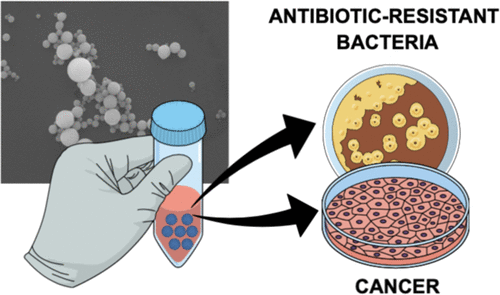Our official English website, www.x-mol.net, welcomes your feedback! (Note: you will need to create a separate account there.)
Naked Selenium Nanoparticles for Antibacterial and Anticancer Treatments.
ACS Omega ( IF 4.1 ) Pub Date : 2020-02-05 , DOI: 10.1021/acsomega.9b03172 Luke D Geoffrion 1 , Tina Hesabizadeh 1 , David Medina-Cruz 2 , Matthew Kusper 1 , Patrick Taylor 1 , Ada Vernet-Crua 2 , Junjiang Chen 2 , Alessandro Ajo 2 , Thomas J Webster 2 , Grégory Guisbiers 1
ACS Omega ( IF 4.1 ) Pub Date : 2020-02-05 , DOI: 10.1021/acsomega.9b03172 Luke D Geoffrion 1 , Tina Hesabizadeh 1 , David Medina-Cruz 2 , Matthew Kusper 1 , Patrick Taylor 1 , Ada Vernet-Crua 2 , Junjiang Chen 2 , Alessandro Ajo 2 , Thomas J Webster 2 , Grégory Guisbiers 1
Affiliation

|
Currently, antibiotic resistance and cancer are two of the most important public health problems killing more than ∼1.5 million people annually, showing that antibiotics and current chemotherapeutics are not as effective as they were in the past. Nanotechnology is presented here as a potential solution. However, current protocols for the traditional physicochemical synthesis of nanomaterials are not free of environmental and social drawbacks, often involving the use of toxic catalysts. This article shows the production of pure naked selenium nanoparticles (SeNPs) by a novel green process called pulsed laser ablation in liquids (PLAL). After the first set of irradiations, another set was performed to reduce the size below 100 nm, which resulted in a colloidal solution of spherical SeNPs with two main populations having sizes around ∼80 and ∼10 nm. The particles after the second set of irradiations also showed higher colloidal stability. SeNPs showed a dose-dependent antibacterial effect toward both standard and antibiotic-resistant phenotypes of Gram-negative and Gram-positive bacteria at a range of concentrations between 0.05 and 25 ppm. Besides, the SeNPs showed a low cytotoxic effect when cultured with human dermal fibroblasts cells at a range of concentrations up to 1 ppm while showing an anticancer effect toward human melanoma and glioblastoma cells at the same concentration range. This article therefore introduces the possibility of using totally naked SeNPs synthesized by a new PLAL protocol as a novel and efficient nanoparticle fabrication process for biomedical applications.
中文翻译:

裸硒纳米颗粒用于抗菌和抗癌治疗。
目前,抗生素耐药性和癌症是最重要的两个公共卫生问题,每年造成约150万人死亡,这表明抗生素和目前的化学治疗方法不如过去有效。此处介绍了纳米技术作为一种潜在的解决方案。然而,当前用于纳米材料的传统物理化学合成的方案并非没有环境和社会弊端,通常涉及使用有毒催化剂。本文显示了通过称为脉冲激光烧蚀液体(PLAL)的新型绿色工艺生产纯裸硒纳米粒子(SeNP)。在第一组辐照后,进行另一组辐照以将尺寸减小至100 nm以下,从而得到球形SeNPs的胶体溶液,其中两个主要族群的尺寸约为〜80和〜10 nm。第二组照射后的颗粒还显示出较高的胶体稳定性。SeNP对浓度范围在0.05至25 ppm之间的革兰氏阴性和革兰氏阳性细菌的标准和耐药表型均表现出剂量依赖性的抗菌作用。此外,当在高达1 ppm的浓度范围内与人真皮成纤维细胞一起培养时,SeNPs表现出低的细胞毒性作用,而在相同浓度范围内,对人黑素瘤和胶质母细胞瘤细胞则显示出抗癌作用。因此,本文介绍了将通过新的PLAL协议合成的全裸SeNP作为生物医学应用的新型高效纳米颗粒制造工艺的可能性。SeNP对浓度范围在0.05至25 ppm之间的革兰氏阴性和革兰氏阳性细菌的标准和耐药表型均表现出剂量依赖性的抗菌作用。此外,当在高达1 ppm的浓度范围内与人真皮成纤维细胞一起培养时,SeNPs表现出低的细胞毒性作用,而在相同浓度范围内,对人黑素瘤和胶质母细胞瘤细胞则显示出抗癌作用。因此,本文介绍了将通过新的PLAL协议合成的全裸SeNP作为生物医学应用的新型高效纳米颗粒制造工艺的可能性。SeNP对浓度范围在0.05至25 ppm之间的革兰氏阴性和革兰氏阳性细菌的标准和耐药表型均表现出剂量依赖性的抗菌作用。此外,当在高达1 ppm的浓度范围内与人真皮成纤维细胞一起培养时,SeNPs表现出低的细胞毒性作用,而在相同浓度范围内,对人黑素瘤和胶质母细胞瘤细胞则显示出抗癌作用。因此,本文介绍了将通过新的PLAL协议合成的全裸SeNP作为生物医学应用的新型高效纳米颗粒制造工艺的可能性。当与浓度高达1 ppm的人皮肤成纤维细胞一起培养时,SeNPs表现出低细胞毒性作用,而在相同浓度范围内,对人黑素瘤和胶质母细胞瘤细胞则显示出抗癌作用。因此,本文介绍了将通过新的PLAL协议合成的全裸SeNP作为生物医学应用的新型高效纳米颗粒制造工艺的可能性。当与浓度高达1 ppm的人皮肤成纤维细胞一起培养时,SeNPs表现出低细胞毒性作用,而在相同浓度范围内,对人黑素瘤和胶质母细胞瘤细胞则显示出抗癌作用。因此,本文介绍了将通过新的PLAL协议合成的全裸SeNP作为生物医学应用的新型高效纳米颗粒制造工艺的可能性。
更新日期:2020-02-18
中文翻译:

裸硒纳米颗粒用于抗菌和抗癌治疗。
目前,抗生素耐药性和癌症是最重要的两个公共卫生问题,每年造成约150万人死亡,这表明抗生素和目前的化学治疗方法不如过去有效。此处介绍了纳米技术作为一种潜在的解决方案。然而,当前用于纳米材料的传统物理化学合成的方案并非没有环境和社会弊端,通常涉及使用有毒催化剂。本文显示了通过称为脉冲激光烧蚀液体(PLAL)的新型绿色工艺生产纯裸硒纳米粒子(SeNP)。在第一组辐照后,进行另一组辐照以将尺寸减小至100 nm以下,从而得到球形SeNPs的胶体溶液,其中两个主要族群的尺寸约为〜80和〜10 nm。第二组照射后的颗粒还显示出较高的胶体稳定性。SeNP对浓度范围在0.05至25 ppm之间的革兰氏阴性和革兰氏阳性细菌的标准和耐药表型均表现出剂量依赖性的抗菌作用。此外,当在高达1 ppm的浓度范围内与人真皮成纤维细胞一起培养时,SeNPs表现出低的细胞毒性作用,而在相同浓度范围内,对人黑素瘤和胶质母细胞瘤细胞则显示出抗癌作用。因此,本文介绍了将通过新的PLAL协议合成的全裸SeNP作为生物医学应用的新型高效纳米颗粒制造工艺的可能性。SeNP对浓度范围在0.05至25 ppm之间的革兰氏阴性和革兰氏阳性细菌的标准和耐药表型均表现出剂量依赖性的抗菌作用。此外,当在高达1 ppm的浓度范围内与人真皮成纤维细胞一起培养时,SeNPs表现出低的细胞毒性作用,而在相同浓度范围内,对人黑素瘤和胶质母细胞瘤细胞则显示出抗癌作用。因此,本文介绍了将通过新的PLAL协议合成的全裸SeNP作为生物医学应用的新型高效纳米颗粒制造工艺的可能性。SeNP对浓度范围在0.05至25 ppm之间的革兰氏阴性和革兰氏阳性细菌的标准和耐药表型均表现出剂量依赖性的抗菌作用。此外,当在高达1 ppm的浓度范围内与人真皮成纤维细胞一起培养时,SeNPs表现出低的细胞毒性作用,而在相同浓度范围内,对人黑素瘤和胶质母细胞瘤细胞则显示出抗癌作用。因此,本文介绍了将通过新的PLAL协议合成的全裸SeNP作为生物医学应用的新型高效纳米颗粒制造工艺的可能性。当与浓度高达1 ppm的人皮肤成纤维细胞一起培养时,SeNPs表现出低细胞毒性作用,而在相同浓度范围内,对人黑素瘤和胶质母细胞瘤细胞则显示出抗癌作用。因此,本文介绍了将通过新的PLAL协议合成的全裸SeNP作为生物医学应用的新型高效纳米颗粒制造工艺的可能性。当与浓度高达1 ppm的人皮肤成纤维细胞一起培养时,SeNPs表现出低细胞毒性作用,而在相同浓度范围内,对人黑素瘤和胶质母细胞瘤细胞则显示出抗癌作用。因此,本文介绍了将通过新的PLAL协议合成的全裸SeNP作为生物医学应用的新型高效纳米颗粒制造工艺的可能性。


























 京公网安备 11010802027423号
京公网安备 11010802027423号